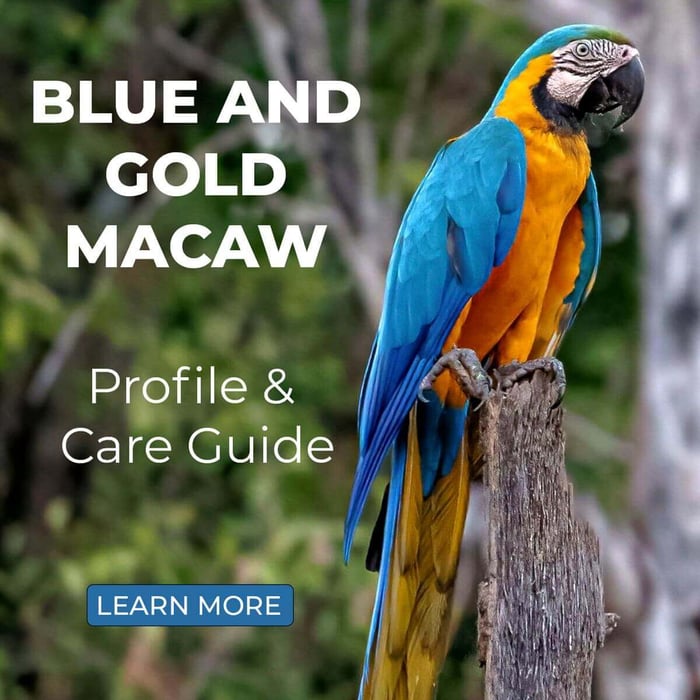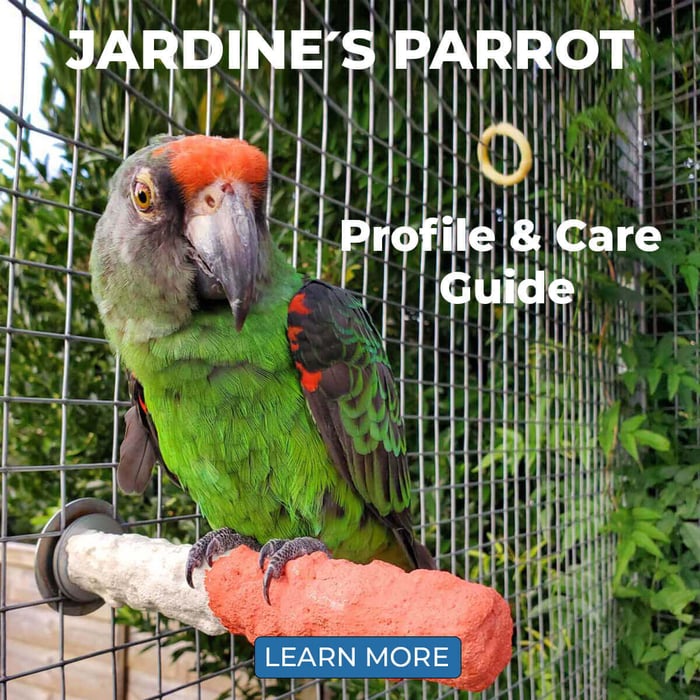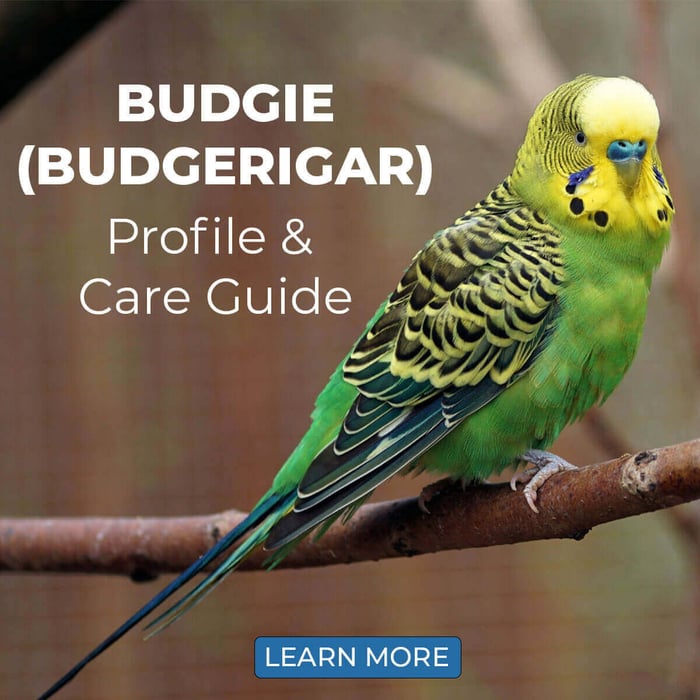Parrotlet – Profile & Care Guide
| Common name: | Parrotlet |
| Scientific name: | Comprises several genera, namely Forpus, Nannopsittaca, and Touit |
| Length: | 8 - 14cm / 3 - 5.5 inches |
| Weight: | 18-28 grams |
| Lifespan: | 10 – 20 years |
| Origin: | Central and South America |
| Noise level: | Moderate, pleasant little chirps |
NATURAL HABITAT
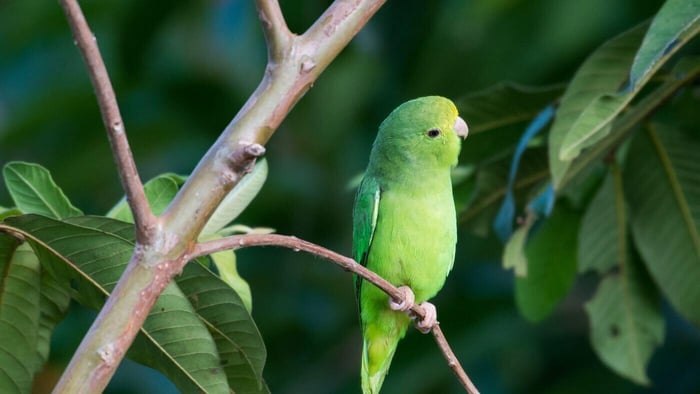
Although there are three different genera of parrotlets, with a total of 19 species, only a few of these are common in captivity. All belong to the tribe Arini within the parrot family, Psittacidae.
The most popular species is the Pacific parrotlet (Forpus coelestis), although the Mexican parrotlet (Forpus cyanopygius), green-rumped parrotlet (Forpus passerinus) and a few others are also sometimes seen in aviculture. Members of the genera Nannopsittaca and Touit are apparently very difficult to impossible to keep alive and breed in captivity.
Wild Forpus parakeets are found in Middle and South America. Here, they inhabit a wide variety of woodlands, ranging from rainforests to arid habitats dominated by cacti. Their distribution spans countries such as Mexico, Venezuela, Guyana, Colombia, Brazil, and more. They are highly adaptable and can thrive in different ecosystems, depending on the specific species.
These parakeets occur in small to medium-sized flocks, generally of a few dozen individuals, and feed on a variety of seeds, fruits, flowers, buds and similar foods.
PARROTLET INTELLIGENCE & PERSONALITY
Despite their small size, these little birds possess the intelligence and attitude of their larger counterparts, like the magnificent Macaws. However, what makes these parakeets unique is their apartment-friendly nature. Unlike the larger Macaws, Parrotlets don't have a tendency to scream, making them an ideal choice for those living in apartments and looking for a quieter parrot companion.
These social birds can even learn to talk and whistle tunes, adding to their charm. These parakeets form strong bonds with their owners and, with dedicated training, can learn simple tricks, providing both you and them with hours of enjoyable entertainment.
TALKING ABILITY
These birds can learn to mimic, but they aren't the best talkers of the parrot family. Some individuals can learn quite a few words, however. They also enjoy learning to imitate tunes and household sounds.
These little birds aren't particularly noisy, so neighbours won't be disturbed. Do keep in mind that they're still not entirely quiet either, and you have to be able to handle a certain amount of daily noise if you'd like to keep one.
FEEDING & SUPPLEMENTS
These little birds have boundless energy and a penchant for play, making top-quality nutrition crucial to keep them going. Their diet should consist of fresh vegetables, leafy greens, fruits, and a combination of top-quality formulated pellet parrots and seed mixes.
When selecting a seed mix, opt for one with low sunflower content that is rich in nutrients. Unlike other parrots, which tend to gain weight easily, these little birds require additional fat to maintain their peak condition. While they enjoy millet sprays, these should be given in moderation, as your bird may end up favouring it over other foods. However, for young birds, providing plenty of millet after weaning is beneficial.
Avoid feeding grit to forpus – and parrots in general. They hull their seeds with their beaks, rendering grit unnecessary and potentially harmful. It can lead to crop impaction and even death. A well-balanced diet, supplemented with mineral blocks, cuttlebone, and vitamins, eliminates the need for grit.
Spirulina and wheatgrass powders are beneficial supplements when used together. Spirulina, an algae grown in the sea, aids digestion, strengthens the immune system, and enhances fertility. It also improves feather colour and condition. Wheatgrass, in turn, contains essential amino acids and trace minerals.
Both supplements contribute to feather conditioning and immune enhancement, particularly during moulting. Breeders use Spirulina and wheatgrass powder to promote fertility and feed it to chicks for stronger, healthier growth and shiny feathers.
Ensure a constant supply of fresh, clean water for your parrotlet. Food and water dishes should be washed daily to maintain hygiene.
HOUSING FOR YOUR PARROTLET
When selecting a cage for your parrotlets, opt for the largest one possible to provide ample space. As a general guideline, the minimum cage size should be 24"x24"x24", but remember that horizontal flying space is more important than cage height.
Pay close attention to the bar spacing, ensuring it is 1/2" or narrower. These parakeets can inadvertently get caught between improperly spaced bars, leading to potential hazards. These little parrots can be too curious for their own good sometimes!
Secure closures are essential for doors and cages. Despite their small size, these little birds are intelligent and capable of learning to open cage doors without locking mechanisms, which can be risky if doors or windows are left open.
While a grated cage bottom is an option, a simple paper liner works just as well.
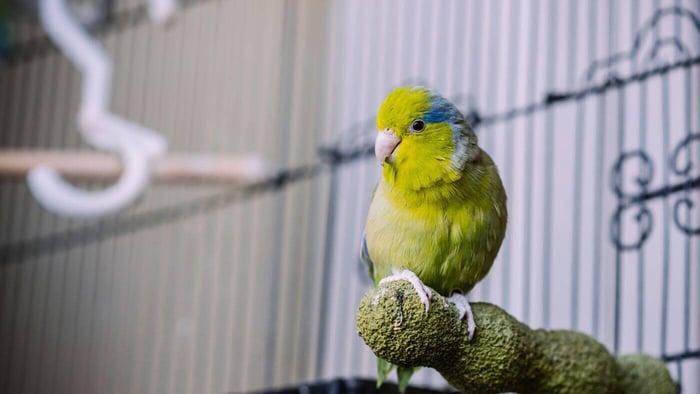
Find a warm spot for the cage, avoiding direct sunlight that may cause discomfort or disturb their rest. It's important to shield parrotlets from drafts to maintain their comfort. Consider placing the cage in an area where your bird can interact with people, such as the living room. The kitchen is best avoided due to potential cooking fumes, which can be unsafe.
Enrich the cage environment with safe parrotlet toys, food and water bowls, and natural perches. Regularly rotate toys and remove any damaged ones to ensure a stimulating and safe environment for your forpus.
FEATHER PLUCKING
These little birds are unfortunately known for their tendency to feather pluck if their needs aren't being met. Because they are such active little birds, they do require a substantial amount of mental stimulation and an adequate amount of undivided attention from their human companions.
If you're not able to spend a good part of the day with your parakeet, you should get a friend to avoid boredom and frustration.
FACTS

- Parrotlets, in general, are feisty, affectionate, and willful. If you want a great companion, it's generally preferable to keep only one bird. A pair of parrotlets will probably bond closely to each other, to the exclusion of the owner.
- Newly hatched, these parakeets are just the size of a bumblebee. Even when they reach maturity, these birds will still be the "littlest brother" of the parrot family. They only grow to half the size of a lovebird and about three-fourths the size of a budgie.
- Parrotlets are dimorphic (meaning there are visual differences between males and females) and easy to pair up, and they do enjoy each other's company. They can also be kept in groups in large aviaries, but it's best to keep them separate from other species. They will quibble and fight over objects and territory, so keep that in mind.
- Male parrotlets have blue markings on their wings, back, and napes, while females have light blue markings near their eyes.
- Baby parrotlets are practically blind and deaf when they are born. They rely completely on their parents for survival. However, they are not mute - you can hear them begging for food just hours after they are born!
- Parrotlets may be small, but they've got huge appetites! Gram for gram, they eat more than macaws.
MORE PROFILES
To view other Parrot Profiles & Care Guides, visit our Alphabetical list of Parrot Fact Sheets by visiting: https://parrotessentials.co.uk/blog/parrot-profiles-care-guides
SOURCES
https://www.iucnredlist.org/search?query=forpus&searchType=species
Parr, M., & Juniper, T. (2010). Parrots: a guide to parrots of the world. Bloomsbury Publishing.

